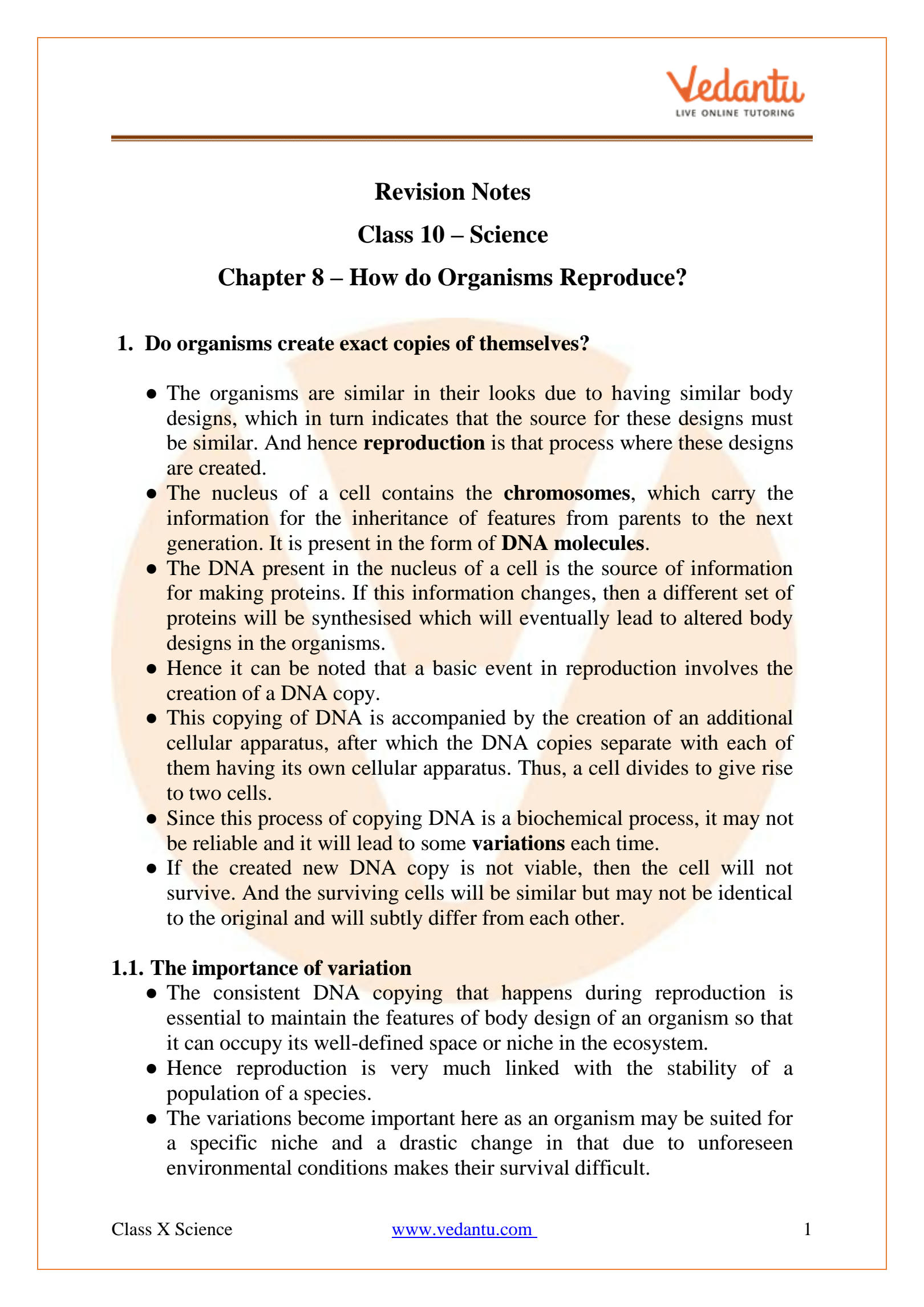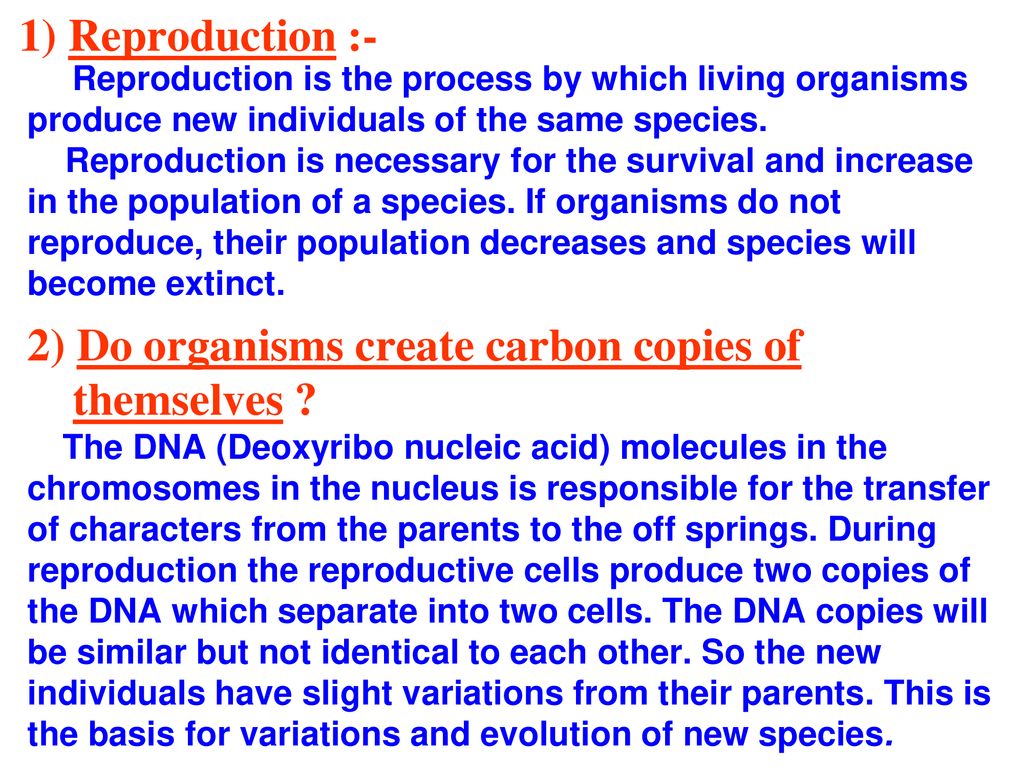Do Organisms Create Exact Copies of Themselves: Understanding Reproduction

Organisms create exact copies of themselves through the process of reproduction. This involves the creation of a DNA copy, where cells use chemical reactions to build copies of their DNA.
Reproduction ensures the continuity of life on Earth and allows organisms to be a part of the ecosystem. In asexually reproducing organisms, variation is restricted, resulting in the creation of clones. However, in sexually reproducing organisms, the probabilities of variation are high.
Every individual life begins with a basic unit called the cell, which contains a nucleus carrying the genetic information for subsequent generations within the DNA. During reproduction, the cell forms a duplicate of its DNA through DNA replication. This replica is then separated from the original DNA, allowing organisms to create exact copies of themselves with some variations.

Credit: pt.slideshare.net
Contents
Asexual Reproduction
Asexual reproduction is a fascinating biological process in which organisms have the unique ability to create exact copies of themselves, a clone. Unlike sexual reproduction, asexual reproduction does not involve the fusion of gametes or the creation of offspring with genetic variations. Instead, a single parent organism is capable of producing offspring that are genetically identical to itself. Let’s take a closer look at the definition and process of asexual reproduction, as well as how exact copies are created.
Definition And Process
Asexual reproduction can be defined as the process in which an organism produces offspring without the involvement or contribution of another organism. This remarkable ability is observed in various organisms, including bacteria, fungi, plants, and some animals. The process of asexual reproduction involves the replication and division of a single parent organism’s cells to create identical offspring.
There are several mechanisms through which asexual reproduction can occur. Some common methods include binary fission, budding, fragmentation, and vegetative propagation. In binary fission, the parent organism simply divides into two equal parts, each having a complete set of genetic information. Budding, on the other hand, involves the formation of a small outgrowth or bud on the parent organism, which eventually detaches and develops into a separate individual.
Fragmentation is another fascinating method of asexual reproduction, commonly observed in plants and some invertebrate animals. This process occurs when a part of the parent organism breaks off and develops into a new, genetically identical individual. Finally, vegetative propagation is a method often observed in plants, where new organisms are produced from vegetative structures such as stems, roots, or even leaves, without the involvement of reproductive organs.
Creation Of Exact Copies
The creation of exact copies in asexual reproduction is a remarkable feat of nature. Since there is no recombination of genetic material between two parent organisms, the offspring are genetically identical to the parent. This means that they carry the same set of genes, and therefore, exhibit the same physical characteristics, traits, and behavior.
One of the key mechanisms behind the creation of exact copies is the process of DNA replication. When a parent organism undergoes asexual reproduction, its cells initiate the replication of DNA. This ensures that each offspring receives a complete and identical copy of the parent’s genetic information, contained within the DNA molecule.
As the replicated DNA is distributed to each offspring, the parent organism undergoes cell division, allowing each new individual to develop independently. This replication process helps maintain the genetic integrity of the parent organism, as well as ensures the preservation of favorable traits and adaptations in the offspring.
By creating exact copies through asexual reproduction, organisms can quickly and efficiently produce large numbers of offspring, rapidly colonize new environments, and ensure the survival of their species. This reproductive strategy has allowed various organisms to thrive and adapt to diverse habitats, demonstrating the remarkable efficiency and resilience of asexual reproduction.
Sexual Reproduction
During sexual reproduction, organisms don’t create exact copies of themselves. Asexually reproducing organisms produce clones with restricted variations. In contrast, sexually reproducing organisms have high chances of variation. Every individual starts with a cell containing genetic information, and DNA replication is the elemental process in creating offspring with some variations.
Process And Mechanisms
Sexual reproduction is a method of reproduction that involves the fusion of gametes from two parent organisms, resulting in the production of offspring with genetic information from both parents. This process begins with the production of specialized cells called gametes, which include sperm cells and egg cells.
The primary mechanism of sexual reproduction is through the process of fertilization, where the sperm and egg cells fuse to form a zygote. This zygote contains a unique combination of genetic material from both parents, resulting in genetic diversity and variations in the offspring.
During fertilization, the sperm cell and the egg cell undergo a series of events that allow them to merge their genetic material. This process involves the fusion of the cell membranes, followed by the fusion of the nuclei and the formation of a zygote.
Variations And Genetic Diversity
Sexual reproduction is crucial for the introduction of genetic diversity in organisms. The fusion of gametes from two parent organisms allows for the shuffling and recombination of genetic material, resulting in unique combinations of genes in the offspring.
Through sexual reproduction, organisms can create exact copies of themselves with some variations. These variations occur due to the random assortment of genetic material during the formation of gametes and the process of fertilization.
The introduction of genetic diversity through sexual reproduction is vital for the survival and adaptation of species. It allows for the possibility of advantageous traits to emerge, providing an evolutionary advantage in changing environments.
The variations and genetic diversity generated by sexual reproduction help populations withstand diseases, environmental changes, and other challenges. It ensures a broader range of traits and characteristics within a species, increasing the chances of survival and successful reproduction.
Role Of Dna In Reproduction
Reproduction is a vital process that allows organisms to create offspring and ensure the continuity of life. Within every cell, the genetic information is stored in the form of DNA (DeoxyriboNucleic Acid). This DNA plays a crucial role in the replication and inheritance of genetic information during reproduction.
Dna Replication
DNA replication is the fundamental process that occurs when a cell divides. It involves the creation of an exact copy of the DNA within the cell. This replication ensures that each new cell receives a complete set of genetic information, maintaining the integrity of the organism’s DNA.
Inheritance Of Genetic Information
The inheritance of genetic information is facilitated by the transmission of DNA from parent organisms to their offspring. Through reproduction, organisms pass on their unique genetic traits encoded in their DNA. This inheritance mechanism enables organisms to create exact copies of themselves while also allowing for variations that contribute to genetic diversity.

Credit: www.studypool.com
Comparison Between Unicellular And Multicellular Organisms
When it comes to reproduction, organisms have fascinating mechanisms for creating new life. The comparison between unicellular and multicellular organisms sheds light on the distinct approaches these life forms take to perpetuate their species.
Reproduction In Unicellular Organisms
Unicellular organisms, such as bacteria and protozoa, have a relatively straightforward approach to reproduction. They typically propagate through a process called binary fission, where a single parent cell divides into two identical daughter cells. This results in the creation of exact copies of the parent organism, maintaining genetic uniformity within the population. Such a mode of reproduction is well-suited to rapidly colonizing environments and exploiting available resources.
Complexity Of Reproduction In Multicellular Organisms
On the other hand, multicellular organisms, like plants, animals, and humans, exhibit a more intricate reproductive process. This involves the fusion of specialized reproductive cells, such as egg and sperm, through sexual reproduction. The offspring inherit genetic material from both parent organisms, leading to genetic variation within the population. This diversity confers adaptive advantages to the species, enabling them to thrive in changing environments and resist diseases.
Additionally, the reproductive cycles of multicellular organisms often encompass elaborate stages, including fertilization, embryonic development, and gestation in viviparous animals. The reproduction of plants may involve pollination, seed formation, and dispersal. These complexities result in the creation of unique offspring, each possessing a combination of genetic traits from their parents.
Comparing the reproduction of unicellular and multicellular organisms underscores the remarkable diversity and adaptability embedded in the mechanisms of creating new life across the biological spectrum.

Credit: slideplayer.com
Frequently Asked Questions
Do Organisms Create Exact Copies Of Themselves Brainly?
Organisms can create exact copies of themselves through asexual reproduction, producing progeny that are genetic clones. However, in sexually reproducing organisms, variations are likely to occur due to genetic recombination. DNA replication is a key process in creating these exact copies.
What Is An Organism Making An Identical Copy Of Itself?
Organisms can create exact copies of themselves through a process called reproduction. In asexual reproduction, organisms produce offspring that are genetically identical to themselves, creating clones. However, in sexual reproduction, there is a higher chance of genetic variation. Both forms of reproduction involve the duplication of DNA to create new life.
What Is It Called When An Organism Makes A Copy Of Itself?
Organisms create exact copies of themselves through a process called reproduction. This can be achieved through asexual reproduction, where the offspring produced is genetically identical to the parent. In this process, the parent organism makes a copy of its DNA and passes it on to the offspring.
How Does Dna Make Exact Copies Of Itself?
DNA makes exact copies of itself through DNA replication, where a cell duplicates its DNA during division. This process ensures genetic information is passed on accurately to the next generation.
Conclusion
In essence, organisms can create exact copies of themselves through reproduction, ensuring continuity and biodiversity. Asexually reproducing organisms produce clones, while sexually reproducing ones offer variations. DNA replication and protein synthesis play vital roles in this process, highlighting the intricate mechanisms of life creation and evolution.




